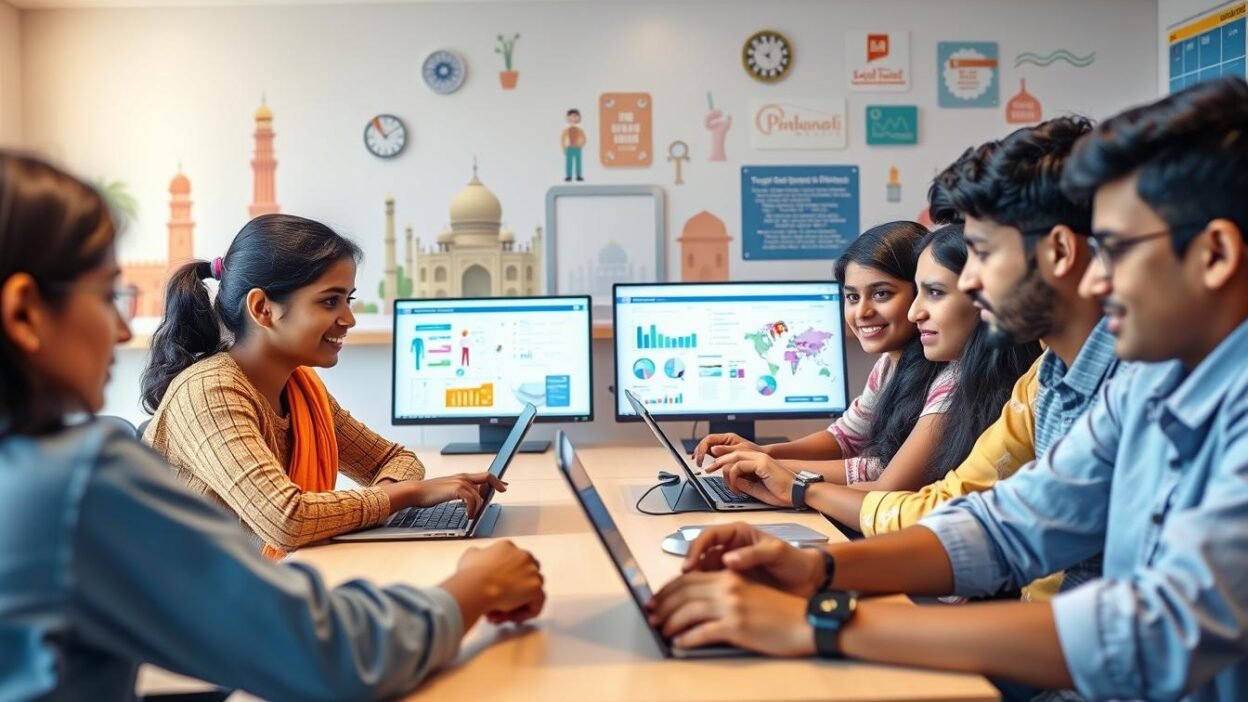Online learning platforms have transformed Indian higher education since 2020. A staggering 93% of institutions have embraced this digital shift. This change brings new opportunities and challenges for educators and students.
Elevating Online Education:
The surge in online education calls for fresh strategies to engage students. Universities are reimagining learning with interactive content and advanced technology. Let’s explore ways to boost student engagement in virtual classrooms.
Preparing for the UGC NET exam can be a daunting task, but with the right resources, candidates can navigate the process effectively. Websites like MyJRF provide a comprehensive platform for aspiring educators, offering specialized guidance for UGC NET Paper 2 preparation and essential tips for acing UGC NET Paper 1. Additionally, understanding the revised syllabus provided by UGC is crucial for a targeted study approach. For official announcements and updates, candidates should regularly visit the UGC NET NTA portal, while the UGC’s job section and the main UGC website are invaluable for post-exam opportunities and academic resources. With these tools, candidates can maximize their preparation and set themselves up for success.
Key Takeaways
- 93% of Indian higher education institutions now use online learning platforms
- Virtual classrooms present unique engagement challenges and opportunities
- Interactive content is essential for successful distance education
- Technology plays a vital role in enhancing the online learning experience
- Effective student engagement strategies are crucial for virtual education success
Understanding the Current Landscape of Online Education
Online education has transformed significantly in India. E-learning tools and digital resources now play a vital role in higher education. These changes have reshaped learning and teaching methods.
Evolution of Online Learning Platforms
Online learning platforms have grown from basic websites to advanced interactive environments. They now include video lectures, quizzes, and discussion forums. In India, SWAYAM and NPTEL offer free, quality education to many students.
Key Trends Shaping Online Education
Several trends are influencing online education in India:
- Mobile learning: With more smartphones, mobile-friendly e-learning tools are becoming popular.
- Personalized learning paths: Education technology now offers customized learning based on individual needs.
- Microlearning: Short, focused modules cater to busy schedules and shorter attention spans.
Challenges Faced by Educators and Students
Online education still faces some obstacles:
- Digital divide: Rural areas in India often lack access to technology and internet.
- Engagement: Keeping students motivated and involved in virtual classrooms can be difficult.
- Assessment: Ensuring fair and accurate online evaluation of student performance remains challenging.
Understanding these aspects is key to improving online education. It helps develop strategies for better student engagement. Ultimately, this leads to improved learning outcomes in the digital age.
Importance of Student Engagement
Student engagement is vital for effective learning in virtual classrooms. It’s crucial for educational success in India’s higher education. Understanding and fostering engagement enhances online course development.
Defining Student Engagement
In virtual classrooms, student engagement means active participation and attention during online sessions. It includes cognitive, emotional, and behavioral aspects of learning.
Benefits of High Engagement
Highly engaged students in online courses often experience:
- Improved academic performance
- Enhanced retention of knowledge
- Increased motivation to learn
- Better problem-solving skills
- Stronger sense of community
Fostering Engagement Techniques
Educators can use various strategies to boost engagement in virtual classrooms:
| Technique | Implementation | Impact |
|---|---|---|
| Interactive polls | Use during live sessions | Increases participation |
| Breakout rooms | Small group discussions | Encourages collaboration |
| Gamification | Incorporate learning games | Enhances motivation |
| Multimedia content | Videos, infographics, podcasts | Caters to diverse learning styles |
These techniques create a dynamic learning environment in virtual classrooms. They improve online course development for Indian students. This approach ensures an effective and enjoyable learning experience.
Designing Effective Online Courses
Careful planning and innovative strategies are key to creating engaging online courses. We’ll explore crucial aspects of online course development. These elements enhance student learning experiences in meaningful ways.
Creating Interactive Course Content
Interactive content keeps students engaged and active in their learning. Digital resources like quizzes, polls, and discussion forums encourage participation. Scenario-based learning helps students apply concepts to real-world situations.
Structuring Courses for Flexibility
Flexible course structures meet diverse student needs. Break content into smaller, manageable modules. This allows learners to pace themselves and revisit topics as needed.
Offer both synchronous and asynchronous learning options. This approach accommodates different schedules and learning preferences.
Utilizing Multimedia Tools for Enrichment
Multimedia tools boost the learning experience. Videos, infographics, and interactive simulations explain complex concepts effectively. These resources cater to various learning styles and improve information retention.
| Multimedia Tool | Benefits | Examples |
|---|---|---|
| Videos | Visual learning, accessibility | Tutorial videos, expert interviews |
| Infographics | Data visualization, quick understanding | Statistical summaries, process flows |
| Simulations | Hands-on practice, risk-free learning | Virtual labs, business scenarios |
These elements create engaging and effective learning experiences. Indian students in higher education benefit from well-designed online courses. Focus on these aspects to enhance your course development.
Leveraging Technology to Enhance Learning
Technology is reshaping modern education in India’s higher education landscape. E-learning tools and education technology are changing how students learn and engage. Virtual learning environments offer new possibilities for interactive and immersive educational experiences.
The Role of Learning Management Systems
Learning Management Systems (LMS) are the backbone of online education. These platforms organize content, track progress, and facilitate communication between educators and learners. Indian universities are adopting LMS to streamline course delivery and boost student engagement.
Gamification in Online Education
Gamification adds game-like elements to learning, making it more engaging and fun. Indian educators use gamified quizzes, leaderboards, and reward systems to motivate students. This approach turns routine tasks into exciting challenges, increasing participation and retention.
Virtual Reality and Augmented Reality Applications
Virtual and Augmented Reality are powerful e-learning tools creating immersive experiences. These technologies bring abstract concepts to life in Indian higher education. VR and AR are used for virtual field trips, 3D modeling, and simulated lab experiments.
| Technology | Application in Indian Higher Education |
|---|---|
| Learning Management Systems | Course organization, progress tracking |
| Gamification | Interactive quizzes, reward systems |
| VR/AR | Virtual labs, 3D modeling, immersive field trips |
Indian institutions are creating more dynamic and effective virtual learning environments. The integration of these innovative e-learning tools is transforming education technology. This shift is setting new standards for online learning in India.
Promoting Collaborative Learning Environments
Online learning platforms have transformed education. They offer innovative ways to encourage student collaboration. Virtual classrooms now prioritize peer learning as a key teaching strategy.
Benefits of Peer Learning
Peer learning in virtual classrooms boosts understanding and retention. Students gain insights from different perspectives, sharpening their critical thinking. This method builds confidence and improves communication skills.
Learners become better prepared for real-world teamwork. They develop abilities crucial for future success.
Tools for Collaboration and Communication
Modern online learning platforms provide various collaboration tools:
- Video conferencing for face-to-face interactions
- Shared document editing for group projects
- Discussion forums for asynchronous communication
- Virtual whiteboards for brainstorming sessions
Encouraging Group Projects and Discussion
Educators can boost active participation in virtual classrooms by:
- Assign group projects that require diverse skills
- Create discussion threads on course topics
- Use breakout rooms for small group activities
- Implement peer review processes for assignments
These strategies help create vibrant learning communities. They mirror real-world collaboration, preparing students for professional challenges. Instructors can foster environments that promote teamwork and shared knowledge.
Providing Continuous Feedback and Assessment
Feedback and assessment are crucial in online education. E-learning tools have changed how educators evaluate students and offer guidance. Let’s explore key aspects of this vital component in education technology.
Importance of Timely Feedback
Quick feedback boosts learning outcomes. Students can improve faster when they get rapid responses. E-learning tools allow instant grading and comments.
Educators can now provide feedback within hours of submission. This quick turnaround helps students adjust their understanding promptly.
Utilizing Online Assessment Tools
Modern education technology offers various assessment options. These tools effectively measure student progress:
- Online quizzes with automatic grading
- Interactive assignments with real-time feedback
- Peer review systems for collaborative learning
- Digital portfolios to track long-term progress
Strategies for Constructive Criticism
Delivering feedback online needs a thoughtful approach. Effective strategies include:
| Strategy | Description |
|---|---|
| Specific Comments | Provide detailed insights on areas of improvement |
| Positive Reinforcement | Highlight strengths alongside suggestions |
| Video Feedback | Use screen recordings to explain complex concepts |
| Rubric-Based Evaluation | Employ clear criteria for consistent assessment |
E-learning tools and strategies create a supportive online learning environment. They foster growth and improvement in students.
Educators can use these methods to enhance their teaching. This approach helps students learn better and achieve more.
Supporting Diverse Learning Styles
Recognizing diverse learning styles is key in online course development. Indian higher education students have varied backgrounds and preferences. Let’s explore how to create inclusive digital resources that engage all learners.
Understanding Different Learning Preferences
Students absorb information in unique ways. Some are visual learners, while others prefer auditory or kinesthetic approaches. Understanding these differences helps educators design comprehensive online courses.
Tailoring Content for Various Learners
Effective online courses offer versatile digital learning resources. These may include video lectures, podcasts, and interactive simulations. By providing multiple formats, educators ensure all students can engage with the material effectively.
| Learning Style | Digital Learning Resource |
|---|---|
| Visual | Infographics, video tutorials |
| Auditory | Podcasts, audio lectures |
| Kinesthetic | Interactive simulations, virtual labs |
Importance of Inclusivity in Online Settings
Creating inclusive online learning environments is crucial. This means making resources accessible to students with disabilities. Providing closed captions for videos and text-to-speech options enhances accessibility.
By prioritizing inclusivity, educators create a more equitable learning experience. This approach benefits all students in Indian higher education.
Building a Strong Online Community
Virtual learning can feel isolating, but strong communities boost student success. Educators can create vibrant online spaces that enhance learning experiences. These strategies help build connections and foster engagement.
Techniques for Creating Student Connections
Intentional efforts are key to building student connections in virtual environments. Icebreakers, group projects, and peer mentoring encourage interaction. Virtual study groups and forums provide spaces for collaboration and academic support.
Role of Social Media in Online Education
Social media extends learning beyond formal classroom settings. Students can join course-specific groups on Facebook or LinkedIn. These platforms allow sharing resources, asking questions, and engaging in academic discussions.
Informal interactions on social media help build relationships among peers. This fosters a sense of community in distance education.
Programming Virtual Events and Activities
Institutions can organize virtual events to create a lively online community. These activities help students connect and engage outside of class time.
- Online guest lectures from industry experts
- Virtual career fairs
- Cultural festivals celebrating diversity
- Online gaming tournaments for stress relief
- Virtual book clubs or movie discussions
These strategies transform virtual learning into dynamic spaces. They foster connection, collaboration, and belonging among distance education students. Implementing these ideas creates a supportive and engaging online community.
Future Directions in Online Education
Online education is changing fast due to new tech and learning platforms. The digital shift in Indian higher education is just starting.
Anticipating Changes in Technology and Learning
New tech will change how students learn in virtual classrooms. AI will tailor courses to each student’s needs. VR and AR will make learning more immersive.
These tools will bring abstract ideas to life. Students will engage with content in new, exciting ways.
Potential for Global Collaboration
Online education is breaking down barriers between countries. Indian students can now access global experts and viewpoints. This mix of cultures will enrich learning experiences.
Students will be better prepared for working in a global setting. They’ll gain skills that are valuable worldwide.
Preparing Educators for the Future of Teaching
As online education grows, teachers need new skills. Training must focus on digital literacy and online teaching methods.
Indian educators can lead in innovative online teaching. They’ll ensure students are ready for the digital world. This shift will benefit both teachers and learners.
FAQ
How can online education be effectively elevated for higher education students in India?
Effective online education needs engaging, interactive content. It should use Learning Management Systems and Virtual Reality. Collaborative learning and continuous feedback are crucial.
Courses must cater to diverse learning styles. Building a strong online community enhances the overall learning experience.
What are the key challenges faced by educators and students in online learning?
Online learning challenges include maintaining student engagement and overcoming technical issues. Adapting to new teaching methods and ensuring equal access to digital resources are crucial.
Educators struggle with online course design. Students face difficulties with time management and self-motivation in distance education.
How can student engagement be fostered in virtual classrooms?
Virtual classrooms can boost engagement through interactive discussions and gamification. Multimedia content, group projects, and real-time collaboration tools are effective.
Regular check-ins and peer interaction are important. Using breakout rooms in video conferencing can enhance the online learning experience.
What role do Learning Management Systems (LMS) play in enhancing online education?
LMS provides a central platform for course delivery and content management. It enables easy access to materials and tracks student progress.
LMS supports various assessments and offers collaboration tools. This streamlines the entire online learning process.
How can online courses be designed to accommodate diverse learning styles?
Online courses should use various content formats like text, videos, and infographics. Multiple pathways through course material cater to different learning preferences.
Offering options for assignments ensures inclusivity. Both synchronous and asynchronous learning opportunities should be included.
What are some effective strategies for providing feedback in online education?
Use rubrics for clear assessment criteria. Leverage automated grading tools for quick responses. Offer personalized video or audio feedback.
Implement peer review systems and use learning analytics. Regular, timely, and constructive feedback is crucial for student engagement.
How can educators build a strong online community among students?
Create spaces for student interaction like forums or social media groups. Organize virtual events and encourage collaborative projects.
Facilitate peer mentoring programs and hold regular synchronous sessions. Promote open communication to foster a sense of belonging.
What emerging technologies are shaping the future of online education?
AI creates personalized learning paths. Virtual and Augmented Reality offer immersive experiences. Blockchain ensures secure credentialing.
Adaptive learning platforms enhance education delivery. IoT creates connected learning environments. Advanced analytics provide deeper insights into student performance.





